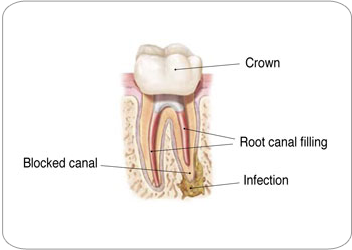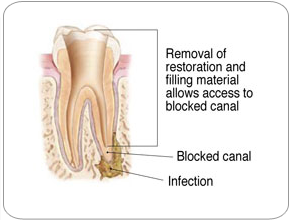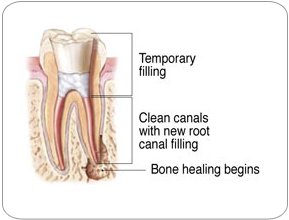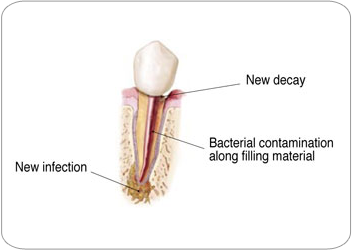Endodontic (Root Canal) Retreatment






Frequently Asked Questions about Endodontic Retreatment
Why do I need another endodontic procedure?
- Narrow or curved canals were not treated during the initial procedure.

- Complicated canal anatomy went undetected in the first procedure.
- The placement of the crown or other restoration was delayed following the endodontic treatment.
- The restoration did not prevent salivary contamination to the inside of the tooth.
In other cases, a new problem can jeopardize a tooth that was successfully treated. For example:

What will happen during retreatment?
- First, the endodontist will discuss your treatment options. If you and your endodontist choose retreatment, the endodontist will reopen your tooth to gain access to the root canal filling material. In many cases, complex restorative materials – crown, post and core material – must be disassembled and removed to permit access to the root canals.

- After removing the canal filling, the endodontist can clean the canals and carefully examine the inside of your tooth using magnification and illumination, searching for any additional canals or unusual anatomy that requires treatment.

- After cleaning the canals, the endodontist will fill and seal the canals and place a temporary filling in the tooth. If the canals are unusually narrow or blocked, your endodontist may recommend endodontic surgery. This surgery involves making an incision to allow the other end of the root to be sealed.

- After your endodontist completes retreatment, you will need to return to your dentist as soon as possible to have a new crown or other restoration placed on the tooth to protect and restore it to its full function.

Is retreatment the best choice for me?
Advances in technology are constantly changing the way root canal treatment is performed, so your endodontist may use new techniques that were not available when you had your first procedure. Your endodontist may be able to resolve your problem with retreatment.
As with any dental or medical procedure, there are no guarantees. Your endodontist will discuss your options and the chances of success before beginning retreatment.
How much will the procedure cost?
While dental insurance may cover part or all of the cost for retreatment, some policies limit coverage to a single procedure on a tooth in a given period of time. Check with your employer or insurance company prior to retreatment to be sure of your coverage.
What are the alternatives to retreatment?
What are the alternatives to endodontic retreatment and/or endodontic surgery?
No matter how effective tooth replacements are – nothing is as good as your own natural tooth. You've already made an investment in saving your tooth. The payoff for choosing retreatment could be a healthy, functioning natural tooth for many years to come.
